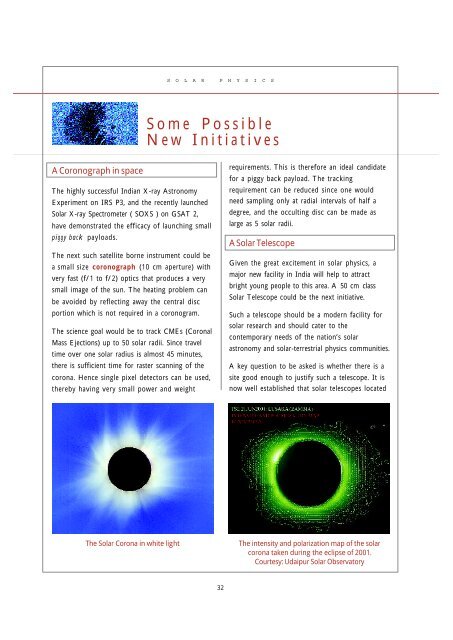2004 ASTRONOMY & ASTROPHYSICS - Indian Academy of Sciences
2004 ASTRONOMY & ASTROPHYSICS - Indian Academy of Sciences
2004 ASTRONOMY & ASTROPHYSICS - Indian Academy of Sciences
You also want an ePaper? Increase the reach of your titles
YUMPU automatically turns print PDFs into web optimized ePapers that Google loves.
SOLAR PHYSICS<br />
Some Possible<br />
New Initiatives<br />
A Coronograph in space<br />
The highly successful <strong>Indian</strong> X-ray Astronomy<br />
Experiment on IRS P3, and the recently launched<br />
Solar X-ray Spectrometer ( SOXS ) on GSAT 2,<br />
have demonstrated the efficacy <strong>of</strong> launching small<br />
piggy back payloads.<br />
The next such satellite borne instrument could be<br />
a small size coronograph (10 cm aperture) with<br />
very fast (f/1 to f/2) optics that produces a very<br />
small image <strong>of</strong> the sun. The heating problem can<br />
be avoided by reflecting away the central disc<br />
portion which is not required in a coronogram.<br />
The science goal would be to track CMEs (Coronal<br />
Mass Ejections) up to 50 solar radii. Since travel<br />
time over one solar radius is almost 45 minutes,<br />
there is sufficient time for raster scanning <strong>of</strong> the<br />
corona. Hence single pixel detectors can be used,<br />
thereby having very small power and weight<br />
requirements. This is therefore an ideal candidate<br />
for a piggy back payload. The tracking<br />
requirement can be reduced since one would<br />
need sampling only at radial intervals <strong>of</strong> half a<br />
degree, and the occulting disc can be made as<br />
large as 5 solar radii.<br />
A Solar Telescope<br />
Given the great excitement in solar physics, a<br />
major new facility in India will help to attract<br />
bright young people to this area. A 50 cm class<br />
Solar Telescope could be the next initiative.<br />
Such a telescope should be a modern facility for<br />
solar research and should cater to the<br />
contemporary needs <strong>of</strong> the nation’s solar<br />
astronomy and solar-terrestrial physics communities.<br />
A key question to be asked is whether there is a<br />
site good enough to justify such a telescope. It is<br />
now well established that solar telescopes located<br />
The Solar Corona in white light<br />
The intensity and polarization map <strong>of</strong> the solar<br />
corona taken during the eclipse <strong>of</strong> 2001.<br />
Courtesy: Udaipur Solar Observatory<br />
32
















